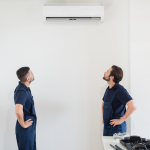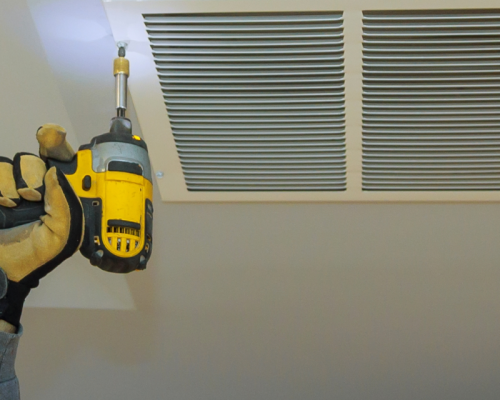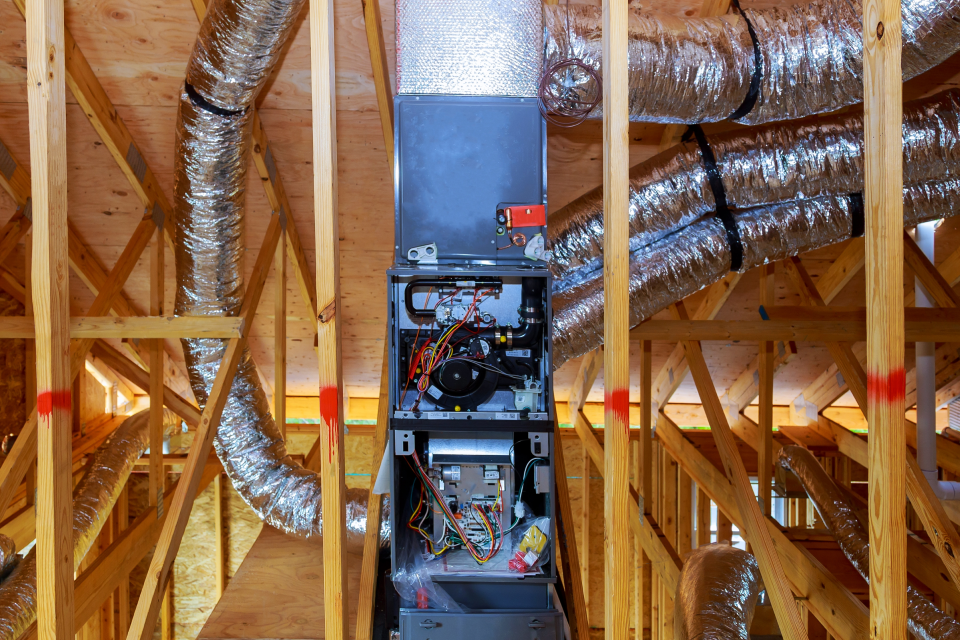
Converting Gas Ducted Heating to Electric
August 18, 2025
Ducted vs Split System Air Conditioning
November 28, 2025How Does Ducted Heating Work

Ducted heating continues to stand the test of time. Providing a highly efficient and versatile solution to keep your home comfortable. A ducted heating system works by sending warm air through the various ducts and vents in your house. Typically, you will encounter two main types of ducted heating, either gas or electric, with components such as a central heating unit, air filter and thermostat. These systems are great because they can distribute heat to all rooms in your home while remaining affordable and energy efficient. Read on to learn everything you need to know about how ducted heating works, its advantages and disadvantages, and the factors to consider before purchasing.
What Is Ducted Heating?
Ducted heating is a central heating system that uses a network of ducts and vents to circulate warm air through a home. The heating unit, typically located in an isolated area such as the roof cavity or external to the home, heats up air which is then transported through ducts to reach your available rooms. These systems help to ensure consistent heating throughout all parts of your home, to maximise comfort.
Types of Ducted Heating Systems
Ducted heating systems come in two major variations. Each choice comes with its own distinct features and advantages:
- Gas ducted heating – Arguably, the most popular heating choice in Australia. These systems rely on natural gas or liquefied petroleum gas (LPG) to warm your house. Gas ducted heaters pull in cold air, which is then heated up within a gas heater, before it’s distributed through ducts to all your rooms. Gas-powered systems are great because they are super energy efficient, meaning they can deliver strong performance without smashing your power bills. Although gas ducted heating can be expensive to install, natural gas is cheaper to run than electricity, so you’ll save in the long run.
- Electric ducted heating – Instead of gas, these systems use electricity to power a heat pump, which distributes warm air throughout your home. While historically the less popular option, electric systems have gained considerable traction in recent years as technology has advanced. Electric ducted heating provides a more environmentally friendly solution, producing zero emissions. Another advantage is that it can also be designed to cool your home. By choosing a reverse-cycle heating and cooling system, you can enjoy year-round comfort in both winter and summer. However, electric heating systems may have higher operating costs than gas, particularly when electricity prices are high.

Components of a Ducted Heating System
The components that make up a ducted heating system include:
- Heating unit – The core of the entire system is the heating unit or furnace. In a gas system, natural gas is burned within the furnace to produce heat. While in an electric system, a furnace uses electricity to heat up the passing air. Your heating units can be installed in various parts of your home, but are commonly placed in a roof cavity or external to the home.
- Fan – A vital component built within your central heating unit. The fan draws cool air from inside your home and directs it through the unit’s furnace before pushing the warmed air back out through the ducts.
- Vents and registers – The visible components of your ducted heating system are the vents, which are installed in your walls, ceiling, or floor. They allow warm air to flow into each room and can be adjusted to control airflow for even heat distribution.
- Ductwork – A network of channels that allows the heated air to be transported from your heating unit to each room. Typically hidden within the frame of your home, concealed in the walls, floors, and ceiling, these ducts transport warm air with minimal heat loss when installed correctly, helping to maximise energy efficiency.
- Thermostat – Your thermostat is the device that allows you to adjust your ducted heating temperature. Modern thermostats are programmable, meaning they can be controlled to specific temperatures at certain times of the day. It works by constantly monitoring your home’s conditions and signalling the unit’s furnace to increase or reduce heat to maintain the desired temperature. Thermostats can be connected to your phone for remote control or displayed as a simple touchscreen device within your home.
How Does Ducted Heating Work?
Although how your ducted heating works will depend upon whether it’s an electric or gas-powered system, it creates warmth through the following process:
- Intake of air – First step in the process, the fan within your heating unit draws in cold air from your home through the return air filter assembly.
- Air is heated – Cold air is then pushed through your system’s furnace. This is run on either natural gas or electricity, using a heat exchanger or electric element to heat the air.
- Air is released – Warm air is released from your central heating unit and pushed by fans through a network of ducts embedded within your home’s frame. It then flows through the vents and registers, distributing heat into each room.
- Temperature controlled – You can use your thermostat to set your ducted heating to your desired temperature. It works by signalling the unit’s furnace to increase or decrease heat as needed to maintain comfortable conditions.
- Return cycle – Once the warm air cools, the process begins again. The system’s return air grille circulates the cooled air back into the central unit, ensuring continuous heating.

How To Use Ducted Heating Efficiently
To ensure you get the most out of your ducted heating system, we recommend the following tips:
- Optimise ducted heating for your home – It’s important to consider how your home’s layout will impact the design of your ducted heating system. Larger homes may require a larger system with additional ductwork and vents to maintain even, efficient heat distribution. Each home presents its own unique challenges. For example, in a two-storey house, heat naturally rises, which can result in the upper level being warmer than the lower level. In this case, zoning may be required to adjust the heating output depending on whether you’re heating upstairs or downstairs. You’ll also need to plan your ductwork carefully to ensure warm air is delivered efficiently to both floors. Your heating experts like Simplyair bringing all the experience needed to tailor a ducted heating system to your home’s design.
- Maintain a stable temperature – Try to use your ducted heating as efficiently as possible. We recommend maintaining a stable temperature of between 18°C to 20°C. Any higher than this will be unnecessary for a well-insulated home. Furthermore, try to keep this temperature stable. Try not to fall into the trap of turning your heater up to maximum to speed up the heating process. All this does is put undue stress on your system and rapidly increase your energy bills.
- Get ducted heating serviced – Your system must be regularly cleaned and serviced. This helps to ensure that your air ducts are properly cleaned from dust and other materials that can negatively affect your system’s output. Without being properly cleaned, your system will have to work harder for a longer period of time to maintain the right temperature. Organising a service can also help to identify any potential problems that can disrupt your heater’s performance. Carbon monoxide poisoning is a big one for unsafe gas heaters, as this can be dangerous if left unchecked. Contact the team at Simplyair for prompt service and repairs.
- Get professional installation – To ensure your heating system operates safely and efficiently, professional installation is always essential. All gas appliances must be connected by a licensed gas fitter to comply with safety regulations. A qualified installer can also provide expert advice on designing a system that best suits your home’s layout. With over 30 years’ experience, the experts at Simplyair can ensure your new ducted system is installed to the highest standard.
Advantages of Ducted Heating
Ducted heating systems can be great investments for the following reasons:
- Whole home heating – One of the biggest advantages of ducted heating is that it can provide warm air to your entire house. This means you can avoid the hot and cold spots that plague other heating methods. This is also unlike portable heating, which is limited only to that area. By utilising the ductwork throughout your home, you can deliver a consistent temperature to every room.
- Temperature control – Modern ducted heating systems offer precise temperature control through advanced thermostats. This not only lets you adjust the temperature to suit your needs but also allows you to program heating schedules for different times of the day. Many thermostats can also be controlled remotely via your smartphone, enhancing convenience and user experience.
- Quick heating – One of the biggest benefits of ducted heating is how quickly it can warm your home, especially gas-powered systems, which deliver consistently fast performance even in large homes or commercial spaces. This makes them an ideal choice for households seeking a quick solution to cold mornings or evenings.
- Energy efficient – Modern systems are designed with energy efficiency in mind. Especially gas-powered systems, which ensure as much heat is created from the available gas as possible. This allows you to save on energy bills, with insulated ducts and vents ensuring minimal heat loss through transport.
- Zoning capabilities – Modern systems can also zone different areas of your home, allowing you to control the temperature in each zone individually, so your bedroom can be a different temperature from your living room. This can also improve energy efficiency by only heating the areas that need it.
How Much Does Ducted Heating Cost?
The exact cost of installing ducted heating will depend upon various factors, such as the size of your home, the type of system you choose and the installation complexity. For example, the more vents that are needed for your home, the higher the cost.
Typically, a brand-new gas ducted heating system will cost less upfront than an electric one. However, these costs can be reduced if you’re replacing your current ducted heating system, as you already have vents and ducts installed.
Furthermore, if you choose to replace your current gas-powered heating with an electric system, you may be eligible for a discount under the Victorian Energy Upgrades (VEU) program. This initiative encourages homeowners to opt for more environmentally friendly systems, such as electric ducted heating, with rebates of up to $5,530 available. For more eligibility information, please visit the VEU here.
Both gas and electrical systems are genuine investments, and it’s important to budget for the cost. To find the exact price points for both a new system and the cost for replacement, please contact the experts at Simplyair for a quote on installation.
Factors To Consider When Choosing a Ducted Heating System
When choosing your ducted heating system, consider these factors:
- Ducted heating system type – It will be important to decide between a gas-powered and an electric heating system. If you’re looking for the type with the highest production, with the most intense heat, then we recommend choosing a gas-powered system. These make them great choices for people with larger homes or in areas particularly prone to cold weather. If you are also looking for a system with low running costs throughout the year, then a gas-powered system will be the more affordable option. Alternatively, if you are looking for a system that can do both heating and cooling, then an electric system may be the more viable option. By installing a reverse cycle system, you can adjust your home’s temperature depending on the time of year. This option is also far more environmentally friendly, with minimal emissions compared to conventional gas-powered. When it comes to deciding on the right ducted heating type, there is no easy answer. Please reach out to the team at Simpliyair, who can provide advice on choosing the right system for you.
- Home Size and Layout for capacity – Make sure you choose a heating system that’s the right size for your home’s dimensions and layout. A system that’s too large will cost more than necessary, while one that’s too small may struggle to adequately heat your home. Experts such as Simplyair, will ensure, through the installation process, that your new heating system is properly sized to meet the demands of your home.
- Energy Efficiency – Consider the energy efficiency of your new ducted heating system before making a purchase. We recommend choosing a system with at least a four-star energy rating. A high-efficiency system helps lower running costs and ensures you get the most out of your heating.
- Servicing requirements – When deciding on the right ducted heating, it’s important to think about the servicing requirements for your system. This is important when deciding between a gas and electric ducted heating system. Gas-powered systems in particular should be serviced annually, or at least every two years. This is to help prevent a gas leak, which could lead to carbon monoxide poisoning if left unchecked. Electrical systems will require less frequent servicing, but we still recommend getting your unit checked every two years to ensure you maintain performance.
Ducted heating is a powerful and efficient way to keep your home comfortable, even during the coldest temperatures. The system works by drawing in cold air, heating it through a central furnace, and then distributing it throughout your home via the ductwork. These heating systems are beneficial because they allow for intelligent temperature control, with strong durability and efficiency. If you are interested in a ducted heating system, contact the experts at Simplyair for more information.
 Schedule a quote
Request a callback
Schedule a quote
Request a callback

Call us Mon-Fri: 8:30am-5pm or leave us a message for a callback.
